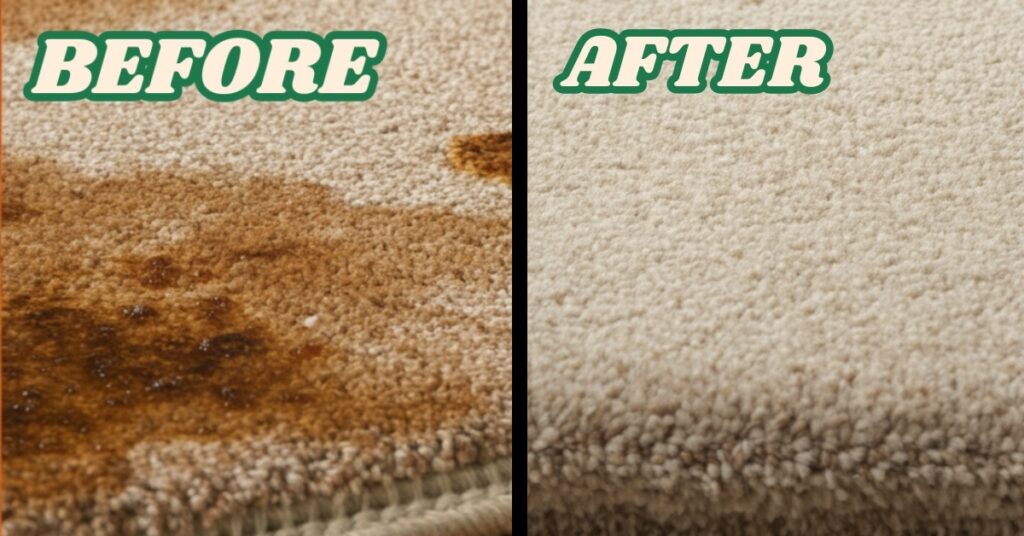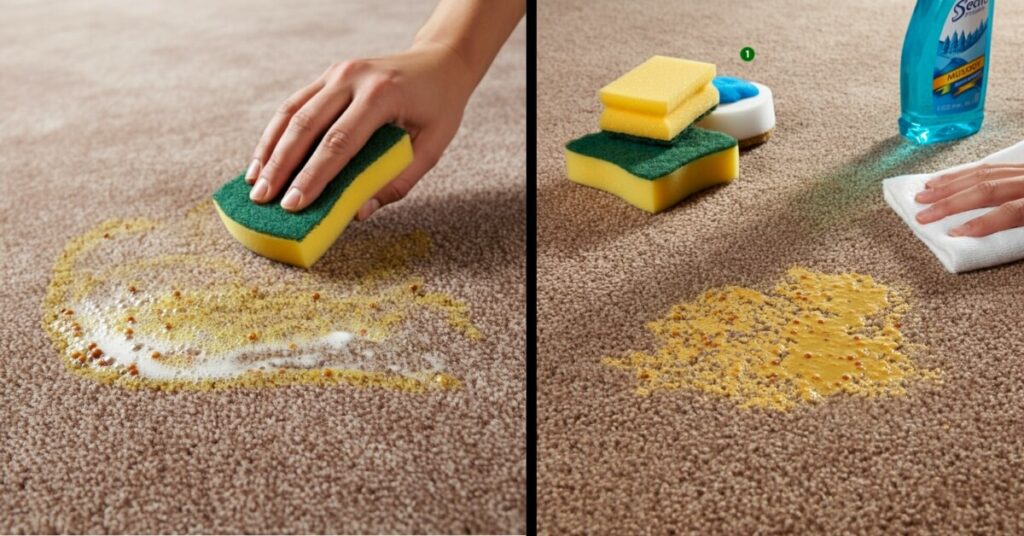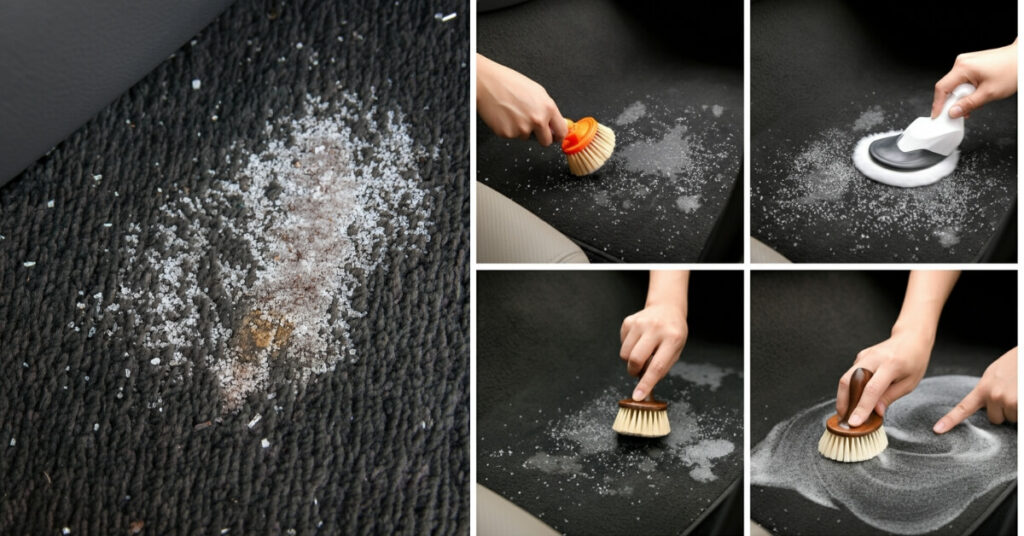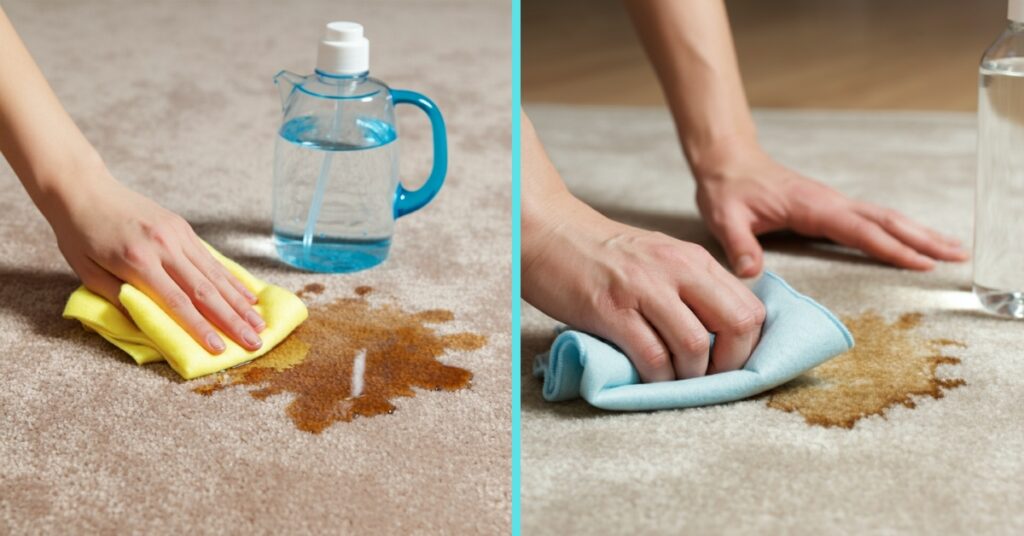As an Amazon Associate, I earn from qualifying purchases.
For DIY fans, wood stains are the rubber spatula spills of crafting, we get it! Anyone who has worked on furniture, especially near carpeted areas, knows how easy it is to spill accidentally. The biggest challenge is figuring out how to get wood stain out of carpet, since most stains are oil or solvent-based and penetrate deep into carpet fibers, making them incredibly difficult to remove.
No need to throw out your perfectly good carpet or cover it up with expensive rugs just yet! Dealing with stubborn wood stains is not as complex as it sounds. With the right tips, timely action, and smart measures, it is possible to restore the appearance of the flooring. This guide will help you understand the potential problems associated with wood stains and provide guidance on how to safely remove them. After all, you wouldn’t want long days of DIY only to be filled with regret later.
Why Is It So Hard to Remove Wood Stain from Carpet?
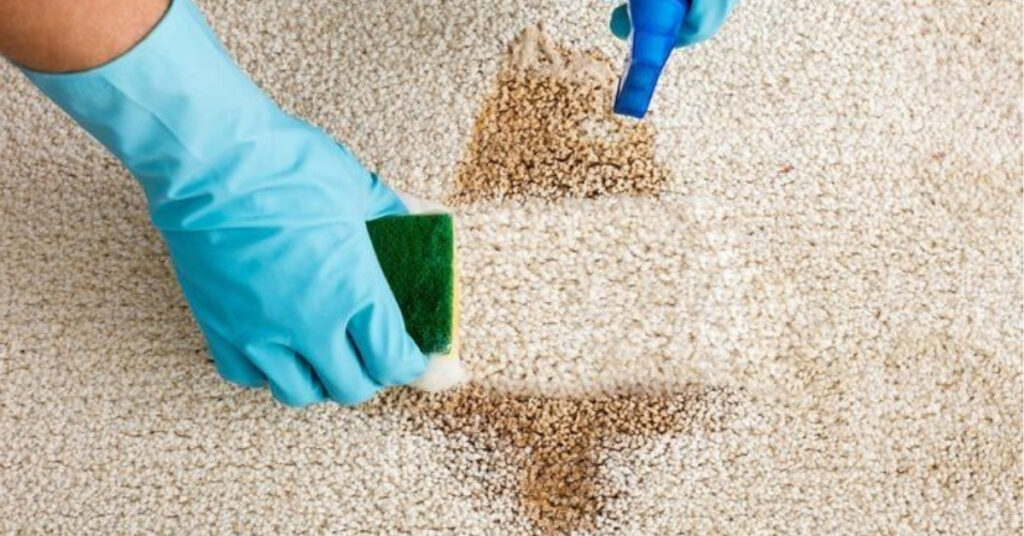
Let’s be honest, wood stains aren’t like most household messes. Regular dirt or even a muddy track through the living room can be dealt with using a vacuum or some mild cleaner. Wood stains, on the other hand, present a unique set of challenges that require quick action.
Deep Penetration
Conveniently, wood stains serve the purpose of “soaking in” to bring out color and character as well as protect wooden pieces of furniture. The ability to penetrate is a curse for carpets. Stains, unlike water spills, which dry on the surface, seep into the carpet pile and padding while binding to fibers almost instantly. This is why it becomes difficult to eradicate the mess.
Complex Composition
Wood stains contain a complex mixture that consists of a strong cocktail of natural or synthetic dyes, pigments, and solvents. Stains carry coloring agents within themselves. When spilled, this mixture instantly bonds chemically with carpet fibers, making it nearly impossible to remove without professional help.
Discoloration Risk
Carpets, particularly lighter ones, are prone to staining. Wood stains have strong pigments meant to change the appearance of wood. A splash of wood stain can darken beige or white carpets. Worse, using the wrong cleaner can “fix” the pigment deeper or cause unwanted bleaching.
Drying Speed
Many wood stains are formulated to dry quickly for convenience in woodworking. Stain drying may aid in the cleaning process. However, the longer it dries, the more firmly it becomes set in the fabric and makes mop-up efforts difficult.
Key Tip: The best strategies for dealing with any form of staining involve quick reactions. In addressing wood spill stains, speed enhances the likelihood of success. Immediate action is vital.
How to Remove Wood Stains from Carpets: A Step-by-Step Guide
Removing wood stains requires the right equipment, an effective approach, and patience. If you have a carpet stain, your best solution is to wood stain the affected area, but first, let’s explore targeted methods for safe and effective removal.
Step 1: Always Blot Stains When They Are Fresh
As soon as you notice a wood stain, make sure to act promptly towards its removal. The first step is using a clean, absorbent cloth or towel to blot the stain. Stains are best removed by pressing, not rubbing, as this can worsen the situation by not only deepening the stain but also spreading it and causing unseen damage.
In the case of wood stain, gently press the stain while changing your towels to prevent the blotting from becoming too messy. Example: Stains without padding, like walnut, can be easily removed by blotting them up with a napkin.
Step 2: Test a Cleaning Agent on a Hidden Area
To prevent irreversible damage to your carpet, you should test your preferred option, whether it is rubbing alcohol or acetone, on a tucked-away area, like floor-level closets with minimal visibility. After applying, wait for 5-10 minutes before assessing changes in color and texture. Why does this matter? Different kinds of carpets are made from nylon, polyester, wool, etc. Some carpets are sensitive and could be damaged by strong cleaners.
Step 3: Rubbing Alcohol or Acetone
After the patch test, the next step is to pour a little bit of acetone or alcohol and using a cotton ball or clean white cloth dab it on the stain. Remember you should pour very limited amounts. Dab the carpet stain while working from the side of the stain toward its center to avoid spreading it. Change the cotton ball or cloth before it gets completely soaked in order to avoid adding the stain back to the carpet.
Feel free to repeat this however many times necessary. Depending on how deep and large the spill is, the process may take more than a few rounds. The help will make it easier to break down the stubborn stain pigments and sticky residue. Important Note: If you plan on cleaning with acetone or alcohol, refrain from directly pouring either onto carpets. This will dampen the carpet pads and backing, which can lead to worse damage.
Step 4: Remove Stains with Soapy Warm Water
After applying the stain removal solvent, warm water mixed with a teaspoon of gentle dish soap in a cup is perfect for dampening a clean white towel to treat the soapy area. This step ensures that any remaining chemicals and pigment are removed, along with your self-made soapy solution.
Be gentle when blotting the carpet. After soaking the towel so it is damp, make sure there is no soap left on the carpet by brushing over the area with a cloth soaked in just water. Any leftover soap or detergent residue can lead to attracting dirt or create a slippery spot. “So do not oversaturate” is a reminder to yourself.
Tip: Use light, non-colored towels while treating the area. Stained towels can lead to discolored spots if they leak dye while being used.
Step 5: Let the Carpet Air Dry
The last step is simple: take a clean towel with no discoloration and dampen the stain, then rub the discolored area in a circular motion, and dry the towel by dipping it into warm water. comes down to white braced sections on Soapy water and scrub. Dampen your towel throughout the entire area, making circular motions while pressing down with a small, swirling motion. Drying is optional until the water evaporates completely. Wrapping in a heavy object will speed up the process.
In the end, set the window or add a fan to help airflow through the carpet for fast air drying. Throughout the drying process, the environment also matters for a clean air spot to speed up drying. Thoroughly drying a carpet prevents odors and crucial mold or mildew growth, especially important when using water and solvents. Learn from our guideline How to Dry Carpet After Cleaning
Step 6: Sprinkle Baking Soda to Absorb Odor or Moisture
Once the area is dry, sprinkle baking soda over the spot generously. Let it sit for several hours, but overnight works best. Then, in the morning, vacuum the area to remove the excess baking soda. Baking soda helps freshen your carpet while further drying out residual dampness.
Read Next: Bissell Little Green Multi-Purpose Portable Carpet Cleaner Review | Is It Worth It?
When to Call For Help
Sometimes, even with the right action, chemicals, and quick action, some stains are difficult to remove. In those cases, a professional’s expertise may be required, along with some special tools that the average homeowner may not have.
- The Stain Is Set: Almost all spills can be cleaned and removed easily, but if a spill has dried for days and you still refuse to call for professional help, then it’s time to seek assistance, as they have powerful solutions made to help with that.
- Color is Fading: If the area losing color becomes fuzzy or bleached while you scrub away, you should stop immediately. This indicates that a professional is needed; otherwise, unwanted damage may be inflicted.
- Expensive Carpet Materials: These are often found in luxury carpets or rugs. They can be made from natural fibers, such as wool, or high-end synthetics. These materials require gentle and specialized care, which can only be provided by experts.
With specialized cleaning equipment such as extractors and solutions, a cleaning company can efficiently restore carpets with minimal damage. While these services do come at a price, the cost is significantly less than replacing an entire carpeted room.
FAQs
Can I use acetone to remove wood stain from carpet?
Yes, you can—but only after a careful spot test. Acetone works very well on synthetic, colorfast carpets for breaking down wood stains. It should be applied gently and sparingly, always with a clean white cloth or cotton ball. Never pour acetone directly onto the carpet.
What if the wood stain is dried?
Dried wood stains are much more challenging, as the pigments have already bonded to the fibers. Start by gently scraping away any crusty residue with a blunt knife. Then follow the main guide steps, repeating the rubbing alcohol or acetone application as needed. Sometimes, professional help is truly the best solution for old stains.
Will wood stain permanently discolor carpet?
Not always—if you act fast and use the correct cleaning agents, many stains can be completely lifted. However, if a stain sets for too long or if the pigment reacts with the carpet dye, some discoloration can be permanent. Always test first and don’t hesitate to contact professionals for older or severe stains.
Is rubbing alcohol safe for all carpets?
Generally, rubbing alcohol is safe for most synthetic carpets when used in moderation. Avoid using it on wool or other natural fibers, which are more delicate. Remember, always do a patch test and proceed carefully.
Can I use a steam cleaner after removing the stain?
Yes! Steam cleaners can be excellent for deep cleaning and deodorizing the carpet after you’ve completed stain removal. But make sure you’ve drawn out as much of the original wood stain as you can first—steam can sometimes set pigment more deeply if any residue is left.
Conclusion
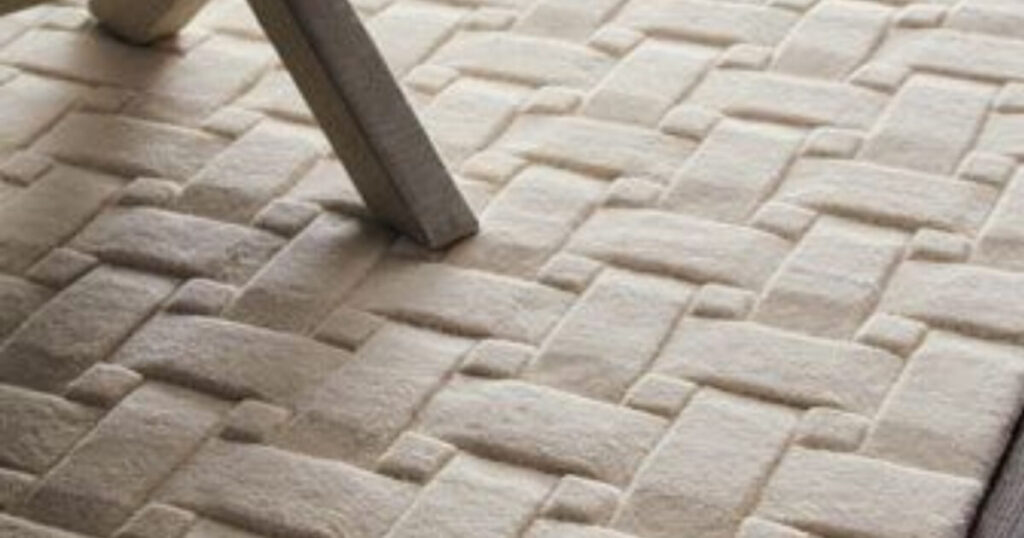
A fun DIY project can quickly spiral out of control if you spill wood stain. The good news is that most accidents can be fixed if you act fast and know exactly what to do.
To clean effectively, remember to: blot instead of rubbing, test before you cleanse, work step by step, and avoid saturating. Best results can be achieved by combining household solutions, such as rubbing alcohol or dish soap, with reliable commercial products like Goo Gone and WD-40 Carpet Cleaner, or even portable deep cleaners from Amazon.
Knowing how to tackle wood stains, along with these detailed steps, empowers you to approach the next home project with confidence by keeping your supplies on hand. If you act fast, your carpets will stay stain-free and look phenomenal for years!
As an Amazon Associate, I earn from qualifying purchases.

